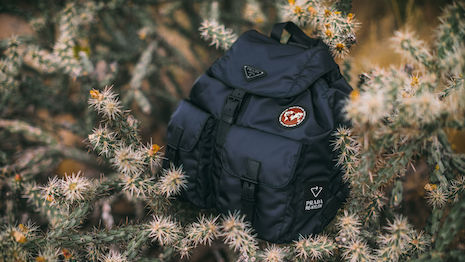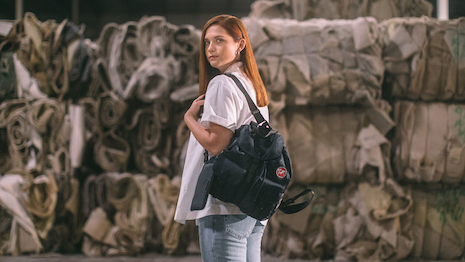Italian fashion label Prada is taking an inventive approach to upcycling by introducing a handbag line made out of regenerated materials, while also examining problems and solutions in the fashion supply chain.
Prada is becoming an active participant in finding sustainable approaches to luxury apparel and accessories production, even as fashion remains one of the most environmentally harmful industries. In addition to launching an alternative material, Prada is sharing a video series that illustrates the process behind its new initiative.
“What I love about the Prada project is that they are being authentically Prada,” said Carrie Phillips, partner at BPCM, New York. “The brand has a history with nylon from Miuccia Prada’s very first must-have bags in the late ’90s.
“This project uses sustainable materials but at the same time looks and feels like Prada,” she said. “This is a great example to other brands that the best way to own your space in sustainability is to do something that resonates with your brand and conveys authenticity to your customers.”
Prada Re-Nylon
The result of a collaboration between Prada and National Geographic, the “What We Carry” series details the process of introducing “Econyl,” a new type of nylon fabric developed with the help of textile yarn producer Aquafil.
Econyl is used to make the totes, belt bags, shoulder bags and backpacks in Prada’s new Re-Nylon line. Re-Nylon products retail between $750 and $1,790.
By the end of 2021, the brand plans to take all Prada virgin nylon and recycle it as Econyl yarn, which can be reprocessed indefinitely without losing quality.
The first episode of Prada’s “What We Carry” series
In the first episode of What We Carry, actress Bonnie Wright and National Geographic’s Asher Jay visit an Aquafil recycling facility in Phoenix, AZ.
According to Prada, less than 3 percent of the 1.6 million tons of carpet discarded in the U.S. each year is recycled.
As part of a circular supply chain, the plant deconstructs used carpet, eventually separating polypropylene and nylon fibers. Nylon-6 can be used in a variety of products, including roads, camping tents and Prada handbags.
“Econyl is a technology that has been around for several years and has gained traction in the sustainability movement because from a material perspective a recycled nylon yarn behaves almost identically to something made from virgin nylon,” Ms. Phillips said. “Prada didn’t focus on the environmental story of discarded fishing nets which has already been told – they took the un-sexy story of carpet and made it look and feel cool.”

Prada Re-Nylon bags are made with upcycled nylon. Image credit: Prada
The film also includes shots of discarded carpeting being delivered to the factory, as well as scenic views of the Arizona landscape that Prada is working to protect.
Future episodes will look at similar upcycling initiatives in Europe, Asia, Africa and Oceania.
Prada and sustainability
Prada has been forward-thinking in its approach to sustainability, which often includes educational components.
Previously, Prada teamed with the Yale School of Management and Politecnico di Milano School of Management to explore how digital intersects with sustainability.
In November 2018, Prada gathered executives and students for a “Shaping a Sustainable Digital Future” conference in Milan. This was the second of Prada’s future-focused events, as the brand seeks to create a conversation around sustainability (see story).
Prada is also one of the latest brands to commit to a fur-free pledge in collaboration with the Fur Free Alliance.
The women’s 2020 spring and summer collections will start under the fur-free pledge, with existing fur inventory available until it is all sold. The group explains that its move is meant to coincide with its socially conscious ideology and will push its labels to be more creative in their designs (see story).
“The most crucial thing to do is speak to customers in your own unique brand voice,” BPCM’s Ms. Phillips said. “Don’t speak in a way that is preachy – bring the customer on the journey with you.”
{"ct":"URXIaf4yQ7jJGIx07kGdvS+lTTTqyIMmLFAu9TyrBHOmVhkwuHn95WPCHV3u9FYZVkK3YTtORdYjd37EpRPtecXxJIUVS3T\/rgSnmmSWF58b4ZMGEG\/Co60oww3q+TSdoyRQUvaGTRYYtzHU7r7OCuPfah\/szrXOu7CuPPE5GETEhQL28J1sKQwqOwCE2dY4aHmD58quxj5DE10Pec7bYhiK6D1RDTNg0HjEiYcuoychyVoNa52Ug5Liltt\/6BHLORgVQhb1WzrhRA2qoQma\/z7Kq6IsfkEpCbsORhVgk+a7SgorkYvUvsmpE6RGDuVs7razPMVCTWRxi22pWH6eL5542sQztU08d+5ASYockGy8JQSHx4BNIFs32bsctk8nA4u34lZSnR34ZCkvneaHVlo4LfX5Uzbwj5L709LRYNm5w+iVzCJhhpgUYfnrrvODtAQwS0YWBNKdGKj9U3DZgfbeyqkYVEq+gQxRWW8tZ9FitYOXByKihVLw\/MT6uxCAzQUKZapOPi0U6ENfoIqxeWFiG9iB95zSnokuR7DrgFk\/cPpAkRQJkdIqyjkJEaf6lxZkT68BCBZO20gJOwh+\/iSQ8kpaz0T8DGciz\/02RB2AGspGFRsBJUhbIRUTJRJEsB5hlF+Yo7kLmztAjwI0qdg\/WgF5SJJzQeH1EK4xa3BzymbOqs7Iqst+SYlGgiFqecqwLQ+iujF5L\/gj1Rrg2+1+AO5lnLgoNTkVIitV47FX97dN6gYLsiAPbN\/AIZQ22BfsBVeNBjogqg3fon9D6l86JWWIrAKmv1GZgCEKVVdcd3kmBoJ7AH5jwIcYqTidZNHph4QGzkiLmPHuxhuoscGmJfEuv9IjmekzrTkLGqCbJlPwbuGWPjxqMeW54qgxOha7rf1oNGrnIzkctroSz+SY0NrQGP7aq62uWL4I4O0hfRDU\/K0lyii2mGxZmzqEsARic70236DXw5SsNlzxpviivJW+dtcjaCnCEwuOOjKdmalwWUUKKjrJQWpDPEOSJ6Tl6kUnJHFvxQrnoamdkTsnPh2fdFlPObb1lZFAthRdNQnttsU\/qujmpRJ6fQbQltGsDGEfEbYLwDQ6jpWoq\/JLQYuhW+TXByHXErdY5gSftsvj0JL2uWMNQ+9i+VpL947AZZL808QAh5L8+uIMKaGczGSS7bbLt+VlHejtXiJ1MsMTyp2NUE0rQcB6QJqoHs5IzGTeBxPHb6b+CUwZX3+6kZvSRQZTAWVxOteLX+NAxdzZqUv3HBvKqCknV+STeyz1CBkJX4BOk10kGFv7L1t6wu5bhKoAeNZ71XoVJrrV+cdaOdU\/x1\/uP0vje1DDqGg2ZltLJDz1StPr15E5Ls6+rB0tXA0uvQFPzDHVHVwqLJtP+yvJ9A0rsqhCmxL9f5My\/DPuYrMUTeHd9y9cupNlSZdygbvTsO4QSPw7IU5cYr9QW+W+3asrLrAgfy\/lV82MF62TW89yQnP6MED3LQN2SpZeC8y1ubwpEWq6BspPJOwt2quvtdAqvPajz1xdElKXzUzrPJuVJ+z53LPBA1orjdLV06WYsTQe1bfLxb4M2yHRsUWG8B5HndazX5MWCRXuO\/Ac8xZ98pteRNYcfqttaqerDmRes0FfPiT\/aCpWAWlkVKcWivxW6Jk95acadxzDLsfYLrZ4G0992MrdkRXYYev6j1Vkc84X6AbdR3H9n7G1iZtUKDXW3WSxUpPf0m+x3MAAAOp7ic8WCWSuj7EuBHFW+DfMqAxguRMAtsLaqugqHSLBUQJ8x2Vphl5wdgML6KZJ\/w64tpEp3v6Gqi5uJf3+fNSdtrjUDkwXIQmic1WAjAFBqLxGK2ZF8AFnd\/Jzu4UnCEPVL\/+IJFamQmVWI7VJrdePsqVxszqaL2leeKwtPQQugNBmBEbn+zOSK0V1D9BceDykqsM2l53aLOnm8oszLhCgY1uSerJZm+P9Ghj4AZbxp4\/o5BjTBZDoi5buIZeAK15ZdTPp2\/gP67LylEWM0xIRUfVSVjM3rZYAxYUVBJ95\/uR4XR3FC5qfFLHfTiZy42S3BhB51koecJXAZNmBmsoyyyXlRjhGmi9xSq8PMf1MyxHAZwqZeR7DEtHXJAYTRkk0R\/SJKIlKHmU\/lpKGwnNeLCW2DooB1+gNakMTiSrw6oz2N2b0jnW4HGqvSU0PDwCzQ5Oo0BwGFm9SZ\/6GfpN56oaLm1ahIOx0IxOn6uZd0T8Sni8qbGcieRQUj2jqJR+uYjURehnMRElSCXSUVOvEWccPFXxp0p6TXtsaxDCLewGk40YFysSdKarK7kWvKxzFegSViT43Wzl++m3VB84yBihcEThmsK0gKnhP+FnvYR5KwZN8nh0VqO7OSoQRhRWBv3k8g7IMMdUDU8eNLiZKi\/AQkcemunf\/E6feipmYHgiJd1zijr3uWnkH4mS\/8R6wek0w\/aspW0A9iqfZwJE2qoS6h6gnfvP2wOy524wIoSjYQpXtE2rksYm52BzvV5SF8eSYF+0jGwUw\/rfZl3aF\/\/NchvCsr++uDHIcVTEZTEzsohBrCfVNc7FlOlMAK3bXdutxCeb\/Adj3w59FXkE9Mxm7bF4GmeKV9xoWs8v79Bx0HG9HM8Q69ubQIywEI9OkLPjTIuBgDOMmjN68\/Ha56ht8fB5tg5lU6m3RUa\/u4fSepJj2HbrZKwRANjB+Xumef8Ztehc57qtOT3qaXPLyaKSN3sfl5SHlQmTDNG16vZF+uUgSc2c1SM4VCnvnFCr+gsZbMGb8HtpDW7\/muSwFZTUpWNB\/KsWU+AJ92YGsxrth38QWVHQ3YaESAMO7q7aQ0dp6ZyC3BUSQ0I4wZHvLnB3hMrAKgiYLRCkMmtn38UtuaNEcrIszl4dekYTKfuZaAw860eZvEibE0BO3PPwSyAKnWgz1GrVPPFx6T3BQ0Z\/tVqYLcxWjkXyUrez+9Y2lOszO5r1gBlc6n5a2ktPOt1Mwex\/CLOPIuAAXupEEwJRqsY4iyb0yZY4BzeTE0pPTZtkw7Dus6TYRI\/++9ktV1x7UnwVODxZfbWlZHkYUIvNYhAJflw4eqwZuVGw0KevbMJUrYQc+v6FQDer85OehYKRa5Nohe4SGtv5PNt4aajHch+KldqhdTFWK4xcUHeW01m5elwocp0OI18R\/y5UnJtdX42H\/9+MLI72r60VxPZs+ku99QMDPnsVS0jRhXFJN0fk4rNIyTF5zlL1lfvYubFnNmRWH2XURiCxcMI3mtIF9K0bJuHTEjgvLwwtO5Dm0IQtBMRE\/Js0Hc3OTOfjG3aSFkBAsQybLG7pMAfvm7CvJGfcx+gJMsVM\/es5VSSDjUiVrtfjLWyrxNg9oOeCSSmhvxfMBzpJEAOpDiYke3CTHY3lA1TcQ355Hskd4+dMcgzHDByE6g6bKi9TOOLyAvmzw+tzMgluejEfW+sfP2lz382OJT3M\/Uq0cC+nfh75cPRrUOB9DC8\/K\/s++QiUSBWWak7HYd7+14mgqor9J2Umb9J05ZU1A2vJq6Xa2r8mIu\/G4YWS4mZoDq1BcmGeylv7AOz88tOK12QKBYgVvWj1ikChb9\/SODvdOBcUgMiWlcZFNivvvNHsvJ8XT0NRr6s+xAxoc6H05Nmmu1Og2WDphTCySu7fiZ2pvwW9bhCwWoHD8Z6V4PX+KTuDrZ65wvg8VRJXPfJ6wh82UzUl8VyeDV1xPGV1b0K0H6FEBt6wunSsC6rvGA5cXYOxxbWyHB\/vgTRayrDJn5OS3l+0qmov7dWNWaHsA1GgwnNF0r\/h0KXHaSF4WkkjHXR98UTbnjCFY\/I5azMD\/s1bLqrJMyBWMzpfLeQHTed+qQSzm81v8ex81AFPHyVW8FwgOlFTiaehyWIEqaxWNoYxH+albGDwE8K1iD2xelqvZPoKtjHCKRtFDeqtsBR220nLcwCfxb6My+evachC9p4rRVMO1LOF3oE1L6eEcodohMVIpPmXc\/6TLnOihyIehLcdGvFtomrDcgipZ3Y3NeJVt+GZbGiSW78uoq4cx8p\/Ig7Wy08mevt1vdNGR04OCkOJlMterh02SZxDrwkSQauouWLoMHJy58\/ebT7\/IxGUhfbQZcl4W1ly47DCkJm2Ui0zUDyVwAMWu9Nu0H8N4PuWpd1v6ZvRnos4D4+a4e2cfziiHeGfhMbNFVkosDsBmcWifj7MGwQL+dLoGNy4UrwNV9UuO+v4hQLbaL8vSAMNQis3\/BaqVDOgqiXMESalqhkb8fi6w0i5VHQ5We4s5nz0zVe3YqGPQmNuXkuvYfBz9gu8dDgAx23a3MDggsDrDiPW239iGaTo8BPHEz6zAmGfAVUh1vx3lZXgG1G5sCOwfxC7ch3raKHfpbWV3Gi62J8Pc+lkzmuMFgPcqnzKxJpsVFHJ1MwTOta9T+n9KApz+O3khtpXm4ZKg0KcO0rXotbmKjNnnjNYGIshjx9M1IXtGs0424r+XMmcOonYO1txSmH+1uC7XuhA2dsy2zLRY+meTXYReMs6QSDQ7ycIc62CnzFWm3O7yXE\/nv0o5xtpZjrr\/+enwzU01rVGXBUcqSozSnuJIIfd\/2+dH1mtjJNhXnkDEWxb2csFm2eVbgJZJeKJRYxadsY9hW0JhCF0Bd4KppyTj8xOMkknn0yKozGCdLy9a9T7BFqeRolNqzaMFwYOqmpoppBI4DkGNu8avQSeUyJEyOGX8wjNY8H92rqj4PIMaaI5STbcMDsSHYTgJUMTLhb2mx8p4NJ80Wbw4DciWa7QzPFRdQlHrSxa4ToIqltGSbuQVWl\/4k5WVO25ZhEe+\/IvgeYSkJDmmoL9EfhCLsfmMyusiSf7pIJKjF6Mhhst2i\/BPEsw6QNOini9m4fiuedCCCmlkSe4TIdiST9r9fcyCOu1A8RnXoILAE\/FbLfNKScpMqqgLy2EpW+oFOKCvA8DhfJV+tbfJfefF1CLAfiOesEen0OW7JPqUT7oaVpb3A3Wcx51L7lDD1\/zcBwhES\/pwvCqrEnmhYl\/WDJJgbTjK6puJej05vnb\/wtB26MJ+ZwzNaYwBg8WZ3bKaxoP4G62yTuj5iYkTcvAXit7M569o\/rkXuwGpcuIpwVAm7ryiO+h1f85xulQs4qZtHKrTXhezGar7l41Pub2fSAgI0YpI8u+cQtFeFTnSeRCIXEcAoFDhpKmrMSYZMlSDR0uOfFgLv7DV6o8DMgWgFXWjGZXxDsQDP1jRdoZU5bIXLl5V\/L8WIoVBOdbZ5kt6G3vqChQJlnBgtlwtmvEYYru3OY0sESt1NAP3uGXndC0mz\/cITRJvtOX8AIH+B9qovtzmaWwsvV3396mFuZXZUyIcTLjqgGpB8DlNBuE\/h6nTcVCUwNYmH22O\/lkx\/BiIcIGajemUYhf9mAfJSCg1KMD57pR1WwAJ97Kl8ct4GUe3QFcFy3\/GAJRqDwoWy8mb3BpptOPNDdhsk3mt0dmPmX82+JEZQGZVh5Bn91Cq2xXSbD95tN0pMIYc4bbvk74A3PYA8duopH6bbfAlfy+3DhxYQaaKuPSrAnylSUK1g1bOXQvSk8eVHSsZPJl5fcQ7IeTqkXmoXnMMLNgP07Y62HuKIptAoIzCDnxukxRij4kE91dwSBlmk4Vtqo8lIhZaOh3LSKK\/usPvhbey6MtB+p2aDBpAOAPVotz9a8VxPSii5VrVG8W4avbLXFIVYa6q6Tu8HCOkjWAIfgcw0xvqk1CIKTuqgwHEoxUF5tM2BSvdgNXpRFZxkbbKoR0kMjXnDIGcyGWzlq8WwR5gqhhUw3CSd0ttcK97NXilvNxEkWBoWzSqvJzlC+GwNPPCeSvBsl2uXWTXt2YMJ8DjgIciL4jbSvbWEeR7ejkKzoxnxwVCkgxl4tpjU7tvYrFZ+6+K5tW3DBqnLTpxE1gQ85FACTr0M8B2uHDe15ANcffwGCf5LLGXRsXS9JjNX4baq3iMLneO0d+NnPrTJziQw7vqE\/myfBariDOdTNgxJo72CF68Wm2dtKQLbjEr\/7po\/NhxMJk77bwK+zg6ITXJ5EyyR\/494g5i2zJKztpIRoIrRgRUr1EbhHasjN3JMf\/fJYSUI3ZwBcdHaHv5O\/dg7ymKGjgX92\/IxcM83AEvK3b7MpPRAiJWPxVPDZMOHIQL6npj17O0hqVJczFh3rKOGotVyjl6ngYiRdSy4DGlf9Bcxt6BmqgrL1KauVXTt8dwa55czi4J99VD1tb3IPZn\/YNpt14cnIZqdDegKDZ6+u4+hP88\/2D9jUMq9HX+7eVEOlMi06JIMi\/Iatb+lrfEwFie5Pai1La\/0OYB180ByybISoL4HwhCunjLo3zqD+eei\/5TB3Db0IClEHc0spNG3fuPyUfFPz9+\/15pvZs+OTe9x5xqKsPuGbZA+l5kVbtUQPLah9uySciNXPsLUuMRJlmQIx8swaMKrDrlgIATArFeGh6Ge35TdL8YR1YPgDc3ZPOZbcCYdHO18rk5Xdh7OAdj+bbJhtzofWEvowbUz26Sh5pLtsXuThLTPw2w5UK6KmKzrs0ie5rBi9Om6LXBfkTsLnIe01Ugd9PrpjBdSFZOZs4spdCoe7o5eZ24vfPNcDzQibR+Nn2Rtt0IoPfIaTYD4L3xfF1vnPWa1ButXv0eVwCUmkGtigP1DECqeVsuV\/ti1MZ1AfjZ4nujHCTvEeFKo2mvPlVL+3Y6RC+RerlXJj33HkpSzBX8Cur3BsmbWM+wislb+TiMuaEiG\/g94mv72fy4K9Tgia\/6xL8Yh1TeyHzDe7bO+yjD0shhVZ8Ew3kfwM9k4OHmmLkcpJ8GtoWRJnlyNETaV\/HKQ0FB3kwOdmDcEGjWQg3gHNY5sUOcbC3kGvVS43gBCI\/g10pxi4iKPdeelPh2wptmM2SGMjkUtwZllF\/dhcmCdyKgyQSN99+tvT2oP78e23O1nC+s7EQT5RmITC4gR8XgsLNUYccXbaYjW4znDnOO6JWzTZAn+qQiFarMKaBLn8Q3AVSfLx9I5l7WKZuLBza49p7K+xtCfokHg6+M0p4peH8F5zi0Gq2jf4wB2tzj\/SbSq2rNH7UXvaxRhWRjV2pQDq5bYOAHFmHZkO7Z5bcPoYO2HZo6","iv":"97c8f92a0027efa06402f1245d5bfba4","s":"7eb9bd3aec9984dd"}

 Actress Bonnie Wright appears in the new Prada Re-Nylon video series. Image credit: Prada
Actress Bonnie Wright appears in the new Prada Re-Nylon video series. Image credit: Prada